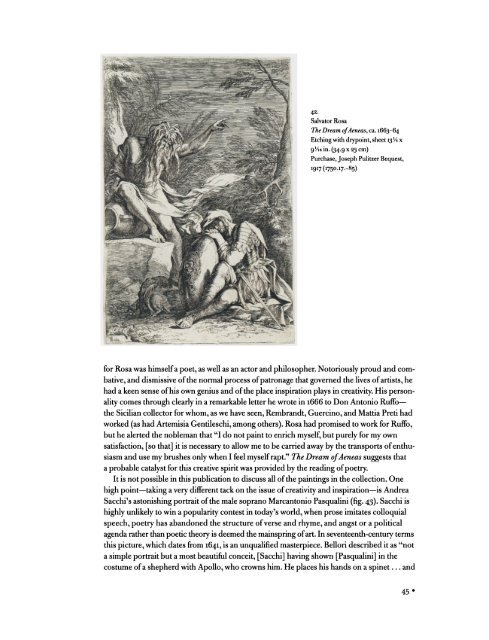GOING FOR BAROQUE Into the Bin - The Metropolitan Museum of Art
GOING FOR BAROQUE Into the Bin - The Metropolitan Museum of Art
GOING FOR BAROQUE Into the Bin - The Metropolitan Museum of Art
You also want an ePaper? Increase the reach of your titles
YUMPU automatically turns print PDFs into web optimized ePapers that Google loves.
42.<br />
Salvator Rosa<br />
<strong>The</strong> Dream<br />
<strong>of</strong> Aeneas, ca.<br />
1663-64<br />
Etching<br />
with<br />
drypoint,<br />
sheet 13 lA x<br />
9 Me in. (34.9x23 cm)<br />
Purchase, Joseph<br />
Pulitzer<br />
Bequest,<br />
1917(1750.17.-85)<br />
for Rosa was himself a poet,<br />
as well as an actor and philosopher. Notoriously proud<br />
and com<br />
bative, and dismissive <strong>of</strong> <strong>the</strong> normal process <strong>of</strong> patronage that governed<br />
<strong>the</strong> lives <strong>of</strong> artists, he<br />
had a keen sense <strong>of</strong> his own<br />
genius<br />
and <strong>of</strong> <strong>the</strong> place inspiration plays<br />
in creativity.<br />
His person<br />
ality comes through clearly<br />
in a remarkable letter he wrote in 1666 to Don Antonio Ruffb?<br />
<strong>the</strong> Sicilian collector for whom,<br />
as we have seen, Rembrandt, Guercino, and Mattia Preti had<br />
worked<br />
(as had <strong>Art</strong>emisia Gentileschi, among o<strong>the</strong>rs).<br />
Rosa had promised<br />
to work for Ruffb,<br />
but he alerted <strong>the</strong> nobleman that "I do not paint<br />
to enrich myself,<br />
but purely<br />
for my<br />
own<br />
satisfaction, [so that]<br />
it is necessary to allow me to be carried away by<br />
<strong>the</strong> transports <strong>of</strong> enthu<br />
siasm and use my brushes<br />
only when I feel myself rapt." <strong>The</strong> Dream <strong>of</strong> Aeneas suggests that<br />
a probable catalyst<br />
for this creative spirit was provided by<br />
<strong>the</strong> reading<br />
<strong>of</strong> poetry.<br />
It is not possible<br />
in this publication<br />
to discuss all <strong>of</strong> <strong>the</strong> paintings<br />
in <strong>the</strong> collection. One<br />
a<br />
high point?taking very different tack on <strong>the</strong> issue <strong>of</strong> creativity<br />
and<br />
inspiration?is<br />
Andrea<br />
Sacchi's<br />
astonishing portrait<br />
<strong>of</strong> <strong>the</strong> male soprano Marcantonio Pasqualini (fig. 43).<br />
Sacchi is<br />
highly unlikely<br />
to win a popularity<br />
contest in today's world, when prose imitates colloquial<br />
speech, poetry has abandoned <strong>the</strong> structure <strong>of</strong> verse and<br />
rhyme,<br />
and angst<br />
or a political<br />
agenda<br />
ra<strong>the</strong>r than poetic <strong>the</strong>ory<br />
is deemed <strong>the</strong> mainspring<br />
<strong>of</strong> art. In seventeenth-century<br />
terms<br />
this picture,<br />
which dates from 1641, is an unqualified masterpiece.<br />
Bellori described it as "not<br />
a simple portrait<br />
but a most beautiful conceit, [Sacchi] having<br />
shown<br />
[Pasqualini]<br />
in <strong>the</strong><br />
costume <strong>of</strong> a shepherd<br />
with<br />
Apollo,<br />
who crowns him. He<br />
places<br />
his hands on a spinet...<br />
and<br />
45*
















